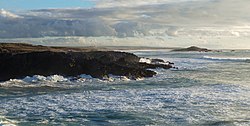
Vila do Porto is the single municipality, the name of the main town and one of the civil parishes on the island of Santa Maria, in the Portuguese archipelago of Azores. Its nearest neighbor, administratively, is the municipality of Povoação on the southern coast of São Miguel, and it is physically southwest of the islets of the Formigas. The population in 2021 was 5,408, in an area of 96.89 km2 (37.41 sq mi).

São Mateus da Calheta is a civil parish within the municipality of Angra do Heroísmo in the Portuguese archipelago of the Azores. The population in 2011 was 3,757, in an area of 5.98 km2. It is located on the periphery of the urbanized area of the city of Angra do Heroísmo, and developed from a small fishing port in a bay along the volcanic coast of the island.
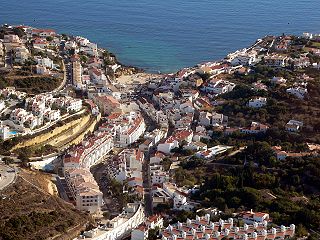
Carvoeiro is a town and a former civil parish in the municipality (concelho) of Lagoa, Algarve, Portugal. In 2013, the parish merged into the new parish Lagoa e Carvoeiro. The population in 2011 was 2,721, in an area of 11.66 km². It is located about 5 kilometres (3.1 mi) south of Lagoa.

Odemira is a town and a municipality in Beja District in the Portuguese region of Alentejo. The population in 2011 was 26,066, in an area of 1720.60 km2, making it the largest municipality of Portugal by area.

Sines is a town and a municipality in Portugal. The municipality, divided into two parishes, has around 14,214 inhabitants (2021) in an area of 203.30 km2 (78.49 sq mi). Sines holds an important oil refinery and several petrochemical industries. It is also a popular beach spot and the main fishing harbour of Alentejo region.

Vila Nova de Milfontes is a town and civil parish (freguesia) in the municipality (concelho) of Odemira, in the Alentejo region in Portugal. The population in 2021 was 5,653, in an area of 76.48 km2.
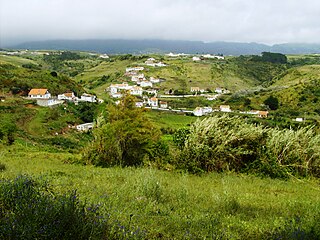
Vila do Porto is a civil parish in the municipality of Vila do Porto, located on the island of Santa Maria, in the Portuguese autonomous region of Azores. It is the southernmost and easternmost parish in the archipelago of Azores. The population in 2011 was 3,119, in an area of 25.55 km².
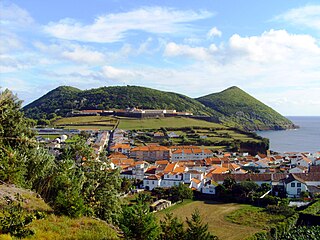
The Fortress of São João Baptista, also known as the Fort of São Filipe or Fort of Monte Brasil is a historic fortress and defensive emplacement, located in the civil parish of Sé, municipality of Angra do Heroísmo in the Portuguese island of Terceira, archipelago of the Azores.

Porto Covo is one of the two civil parishes in the municipality of Sines, located along the western Alentejo coast of Portugal, about 170 km (110 mi) south of Lisbon. The population in 2011 was 1,038, in an area of 50.72 km2. Known for its beaches and ties to the ocean, the name Porto Covo likely translates as port of the covos, the term covo referring to a fishing net, used for capturing lobsters and crabs.

The Fort of São Sebastião de Caparica also known as the Tower of São Sebastião or Fortress of the Old Tower is a medieval fortification located in Monte da Caparica, civil parish of Caparica, in the municipality of Almada, in the Portuguese central region of Península de Setúbal.

The Fort of São João do Arade, sometimes referred to as the Castle of Arade, is a medieval fortification situated in the civil parish of Ferragudo in the Portuguese Algarve municipality of Lagoa.

The Fort of Nossa Senhora da Rocha is a medieval castle situated in the civil parish of Porches, in the municipality of Lagoa in Portuguese Algarve. Inside the fort is the Chapel of Nossa Senhora da Rocha, of uncertain date.
The Três Paus redoubt is a redoubt fortification situated on the peninsula of Monte Brasil, in the civil parish of Sé, in the municipality of Angra do Heroísmo, in the Portuguese archipelago of the Azores. Part of the fortified defenses of the Fortress of São João Baptista, it was also known as the Fort/Redoubt of Benedict the Moor.

Fort of Santa Cruz, is a 16th-century fortification located in the civil parish of Angústias, municipality of Horta, on the island of Faial in the Portuguese Azores. Occasionally referred to as the Castelo de Santa Cruz by locals, it is situated in the historic centre of the city, on the edge of Horta Bay. It was constructed to work in conjunction with the Fort of Bom Jesus at the mouth of the Ribeira da Conceição and Fort of Greta along the coast of the extinct spatter cone Monte da Guia, to defend the entrance to the harbour and southern access to the Bay.

The Fort of São João Baptista das Berlengas, or simply known as the Fort of the Berlengas, is located off western coast of Portugal, on the largest island of the archipelago of the Berlengas, in the municipality of Peniche in Oeste region. The fortification belonged to a group of defensive military structures meant to protect the municipality located on the coast.
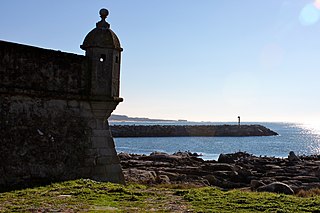
The Fort of Lagarteira is a medieval fort in the civil parish of Vila Praia de Âncora, municipality of Caminha in the Portuguese Norte, classified as a Property of Public Interest.

The Church of Porto Covo is Baroque and Neoclassic church in the civil parish, municipality of Sines, in the Atlantic coast of the Portuguese Alentejo. The church's austere lines is a morphological hybridization of the styles employed during the reign of Queen Maria I. In the widespread typology of regional architecture, the Baroque elements are evident in the lintels and trim curves, framed in a composition that is, generally, more rigid then in the gable design.

The Lighthouse of São Miguel-o-Anjo is a former hermitage and 16th century lighthouse, in the civil parish of Aldoar, Foz do Douro e Nevogilde, municipality of Porto, in the Portuguese Norte Region. The lighthouse of São Miguel-o-Anjo is Portugal's oldest existing lighthouse and one of the oldest in Europe. Designed by Italian architect Francesco da Cremona, the project was completed in 1538.
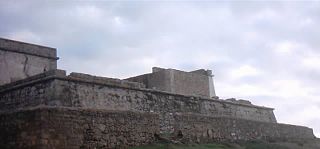
The Fort Nossa Senhora da Queimada also knows as Fort of Pessegueiro is a fort situated along the coast of the civil parish of Porto Covo, municipality of Sines, in the southern Alentejo of Portugal, across from the island of the same name.

The Fort Nossa Senhora da Luz, also known locally as Castle of Senhora da Luz is a fort in the civil parish of Luz, municipality of Lagos in the Portuguese Algarve, classified as a Property of Public Interest.
